Supplement: "The Stars in Their Courses":
Celestial Motions Revisited
Key Ideas:
Apparent Motions
- Consequence of viewing the Universe from the
perspective of a moving Earth.
Simple Motions
- Earth's Rotation: Rising and Setting of the Stars
- Earth's Orbit: The Sun's Annual Motion along the Ecliptic
Compound Motions
- The Solar Day
- The Lunar Month
- Sidereal vs. Synodic Periods
Complex Motions
- Eclipse Cycles
- Retrograde Motions of the Planets
Celestial Motions Revisited
We will review the wide range of apparent motions that we have been
discussing the last week or so, with the goal of understanding what
these motions are from a modern perspective.
Having seen all the motions individually, and with some detail,
let's revisit them in general to cement the basic principles.
Apparent Motions
How an object appears to move through the sky is a consequence of
- How the object is actually moving through space ("true motion")
- How your vantage point is also moving through space.
The combination pf motions results in the object's apparent motion.
- What we perceive is the relative motions of the two
- Our choice of vantage point establishes our "Frame of Reference".
An Earth-Centered Perspective
For most naked-eye astronomical observations of interest to us here, our
vantage point is the Earth, which has two basic true motions:
- Daily Rotation about its axis (24 hours/day)
- Annual Orbit around the Sun (approximately 365.25 days/year)
These two motions, combined with the actual motions of the objects
we are viewing, gives rise to their apparent motions across
the sky.
Simple Motions
The simplest apparent motions are those due to one of the motions of
the Earth, either its rotational or orbital motion.
Apparent Daily Motions
Apparent Daily Motions reflect the rotation of the Earth about its axis.
A good illustration is the apparent daily motions of the stars:
- The stars appear to rise in the east and set in the west, returning
to the same place in your local sky a little under 24 hours later
(precisely, 23h 56m 04s = 1 sidereal day).
- The apparent paths of the stars are circles parallel to the
Celestial Equator that are tilted relative to the horizon by a
angle of (90-latitude).
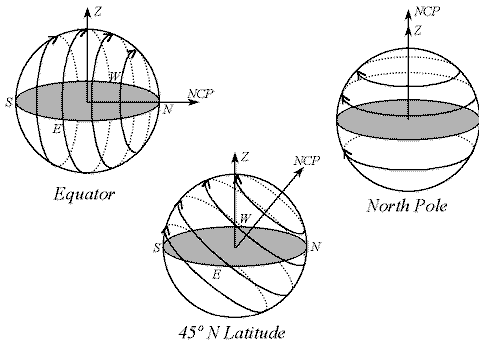
(Click on the image to view it in color at full resolution [Size: 21Kb])
In Columbus: we are at 40° N, so the paths are tilted by
(90°-40°)=50° from our local horizon.
This motion defines the "sidereal day" - the day measured with
respect to the stars.
Apparent Annual Motions
Apparent Annual Motions reflect the orbit of the Earth around the Sun.
A good illustration is the apparent annual motion of the Sun:
- The Sun appears to travel eastward (west-to-east) across the
Celestial Sphere along the Ecliptic
- The Ecliptic is a great circle tilted by 23.5° from the Celestial
Equator (the "Obliquity of the Ecliptic").
- The Sun takes 1 year (365.2422 days) to go one complete circuit
around the Ecliptic from March Equinox to the next March Equinox
(called a "Tropical Year").
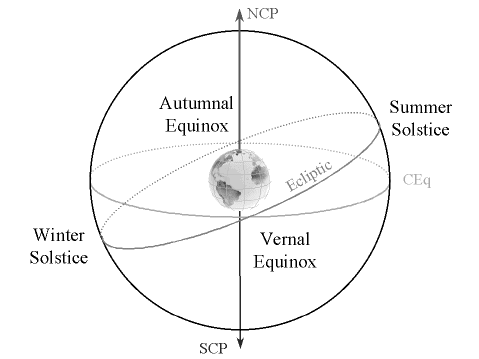
(Click on the image to view it in color at full resolution [Size: 22Kb])
This motion defines our "Calendar Year" with respect to the seasons.
Compound Motions
Compound motions, in their simplest form, combine two motions together
to make one apparent motion.
The Solar Day
A good example of a this is the "Solar Day", which combines two
motions:
- The rotation of the Earth, which causes the Sun to appear to rise
in the east and set in the west over the course of a day.
- The orbit of the Earth, which leads to a slow eastward motion of the
Sun along the ecliptic relative to the fixed stars
Starting with the Sun on your meridian (Local Noon),
- After one rotation with respect to the stars, the Sun is now
located a little bit to the east of your meridian.
- 4 minutes later (precisely: 3m 56s), the moves the remaining
distance to your meridian, and it is Local Noon again
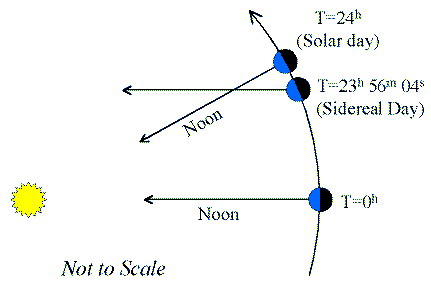
(Click on the image to view at full scale [Size: 9Kb])
This leads to two different ways of measuring the "day":
- The Sidereal Day of 23h 56m 04s which measures the rotation of
the Earth relative to the Stars.
- The Solar Day of 24h which measures the rotation of the Earth
relative to the Sun.
The first is used primarily by astronomers (since we often point telescopes
by the stars), whereas the second is the basis of our civil timekeeping
system.
The Lunar Month
Another example of compound motions is the Lunar Month, which
combines these two motions:
- The orbit of the Moon around the Earth, which appears as an
eastward motion relative to the stars. This takes about 27.3 days
to complete one orbit with respect to the stars (the sidereal
month).
- The orbit of the Earth around the Sun, which causes the location
of the Sun to slowly move eastward along the Ecliptic.
Starting with New Moon (see Lecture
8):
- After one lunar orbit (1 sidereal month of 27.3 days), the Moon now
appears west of the Sun in the sky, and is in its Waning Crescent phase.
- About 2.3 days later, the combined motion of the Moon and Earth
moves it east enough that it is once again New Moon.
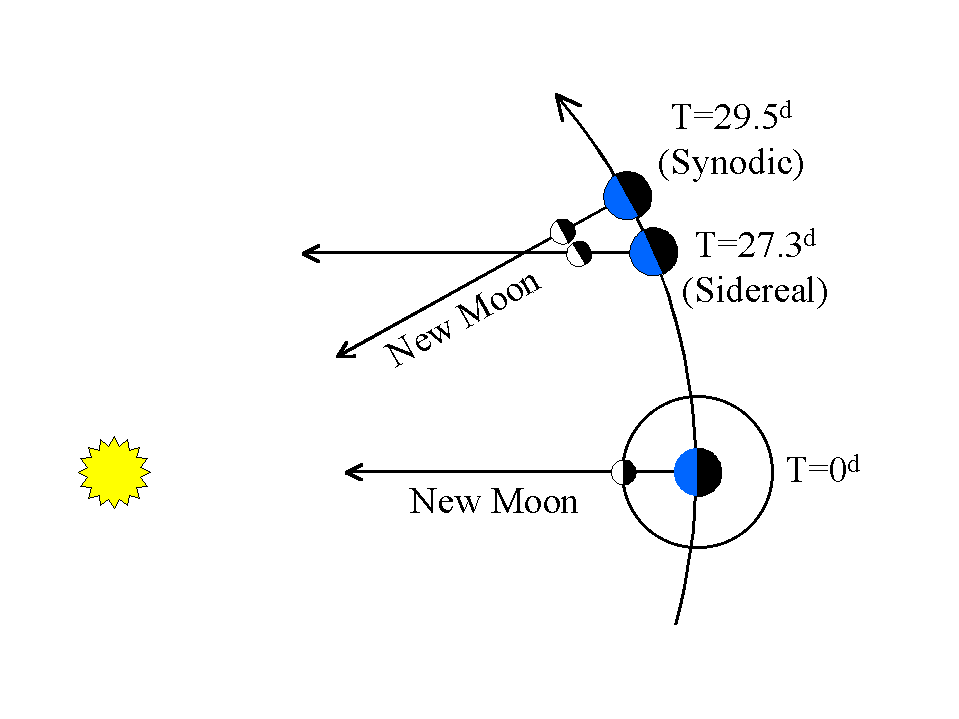
(Click on the image to view at full scale [Size: 9Kb])
The combined motion gives the Lunar Month of 29.5 days (also called
the Synodic Month).
Sidereal vs. Synodic Periods
The time it takes any cyclic (repeating) phenomenon (e.g., rotation or
orbit) to complete one full cycle is called its Period
Sidereal Period
- The time it takes for a cyclic motion to repeat with respect to the
fixed stars.
Examples:
- The Sidereal Day (one Earth rotation relative to the stars)
- The Sidereal Month (one Moon orbit around the Earth relative to the stars)
- The Sidereal Year (one Earth orbit around the Sun relative to the stars).
The word Sidereal comes from the Latin sidus, meaning "a star".
Sidereal periods are related to "simple" motions as described above.
Synodic Period
- The time it takes for a cyclic motion to repeat with respect to another
body in the Solar System.
Examples:
- The Solar Day (one Earth rotation relative to the Sun - technically
we could call this a "Synodic Day", but that's confusing).
- The Synodic Month (one Moon orbit around the Earth relative to
the Sun, or the interval between successive New Moons)
- The Synodic Period of a Planet. Time between successive
Oppositions of a Superior Planet, or successive Inferior Conjuctions
of an Inferior Planet.
The word Synodic comes from the Greek synodos, meaning "a meeting" or
"coming together" (e.g., a "Church Synod").
A Synodic Period measures how long it takes a 2-part compound motion
to occur, as it depends on two things "coming together":
- A Solar day measures how long it takes the Sun and your local meridian
to come together again in your sky.
- A Synodic Month measures how long it takes for the Sun and Moon to come
together again as seen from the Earth (i.e., New Moon to New Moon).
- The Synodic Period of a planet measures how long it takes for the planet
and the Sun to come together again as seen in the sky of the Earth (i.e.,
the time between successive oppositions or conjunctions).
Here's a problem to think about for yourself:
What is the Synodic Period of a mechanical clock (i.e., how often
do the hands come together, for example as at noon or midnight)?
Complex Motions
The final kind of motion we have encountered can be described as
"complex" motions.
The Eclipse Year
Eclipses of the Sun or Moon occur only when the Earth, Sun, and Moon
are exactly aligned in the sky.
Because the Moon's orbit is tilted with respect to the Ecliptic (by
about 5 degrees), so there are only two possible points of alignment,
along the "Line of Nodes".
You only get eclipses when both of these things happen:
- It is new Moon or full Moon, which repeat every Lunar Synodic
Month (29.5 days).
- The Sun lines up with the line of nodes (happens every 346.6 days,
the Eclipse Year).
This requires 3 motions to combine (orbit of the Moon, orbit of the
Earth, and the alignment of the line of nodes).
This fact makes eclipses fairly rare as seen from any given place on
the Earth, though 2 or more total eclipses occur every year.
Retrograde Motions of Planets
Seen from the perspective of the Sun, the planets all orbit the Sun
at different speeds relative to the fixed stars:
- All Planets (including Earth) orbit in the same general
direction around the Sun.
- Planets closer to the Sun orbit faster than the Earth.
- Planets further from the Sun orbit slower than the Earth.
Seen from the Earth, however, the apparent motions are complicated
by the different speeds:
Superior Planets (Mars, Jupiter, Saturn, etc.):
- Earth passes them at Opposition.
- Around opposition, they they appear to move west
or retrograde relative to the stars.
- Once we've passed by, they appear to continue their general
eastward or prograde motions, just like the eastward
motions of the Sun and Moon relative to the stars.
Retrograde Motion of Mars:
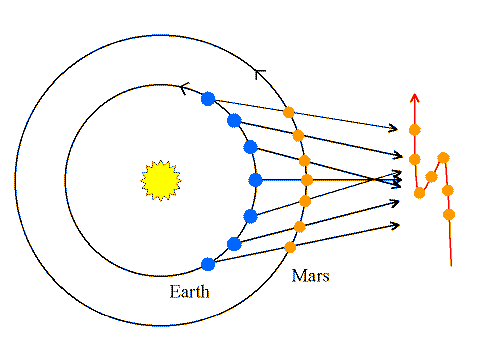
(Click on the image to view at full scale [Size: 11Kb])
Inferior Planets (Mercury & Venus):
- The Earth is overtaken and passed by the planet at Inferior
Conjunction.
- This causes the planet to appear to move west
or retrograde relative to the stars.
- Once they've passed by, they appear to continue their general
eastward or prograde motions.
An additional complication is that the planes of the orbits are
not all aligned with the ecliptic. When seen at different parts
of the orbits, the retrograde paths can be closed loops or
S-shaped curves, depending on how they are projected onto our Sky.
This complex motion was very difficult to explain when viewed from the
ancient (and arguably "common-sense") perspective of a fixed, unmoving
Earth.
Return to [
Unit 2 Index
|
Astronomy 161 Main Page
]
Updated: 2007 September 16
Copyright © Richard W. Pogge, All Rights Reserved.